Politics
Why Modi Allowed Shah's Wings To Be Clipped
Surajit Dasgupta
Jan 11, 2016, 08:46 PM | Updated Feb 10, 2016, 05:09 PM IST
Save & read from anywhere!
Bookmark stories for easy access on any device or the Swarajya app.
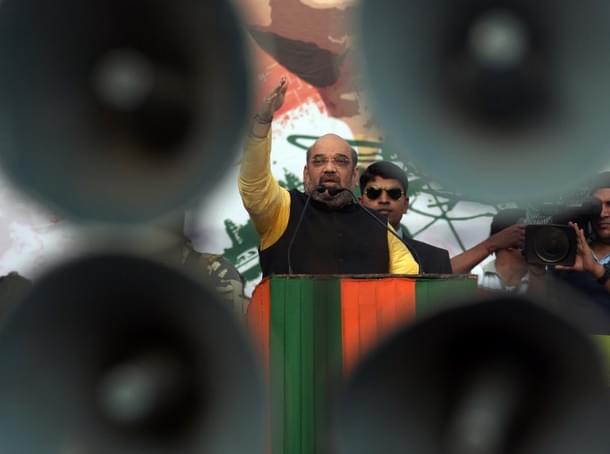
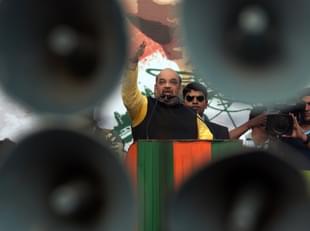
The Bihar electoral snub was the final straw; Modi has decided to let state units of the BJP do what they want while his man stays on top without bothering the bottom much
Narendra Modi came to lead the Bharatiya Janata Party in 2014 with the mandate of the people to govern India right; but before that, in 2013, when he was made the head of the party’s election campaign, he had a mandate from the Rashtriya Swayamsevak Sangh and also an expectation from BJP’s core, traditional voters: Clean the organisation.
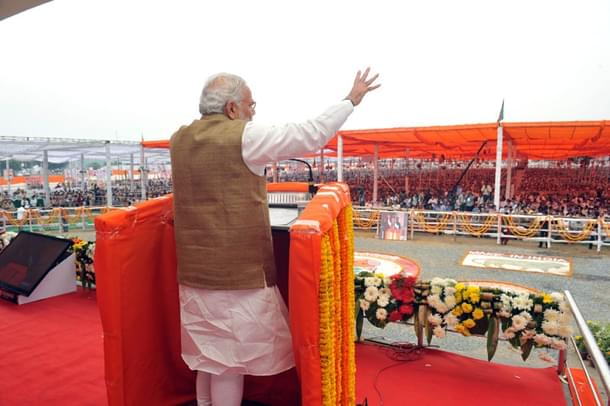
In separate articles in the past, I have explained what was going on backstage to create a virtual uprising in the country in 2011. Those facts and theories were, however, not about the crowd. If the crowds swelled in an unprecedented manner at Anna Hazare’s show, it was equally a poor commentary on the state of the BJP in that period.
Party patriarch LK Advani knew about it the best — especially when he couldn’t make his leadership appear as a viable alternative to the UPA, even after the 26/11 attacks just a few months before the 2009 elections. So when a little known NGO head called Arvind Kejriwal, accompanied by a mutual acquaintance Lavleen Thadani (theatre personality), approached a defeated, crest-fallen Advani to suggest ways of launching a rebellion of sorts against the corruption-ravaged Manmohan Singh government, the grand old man of Indian politics told the wannabe rabble-rouser that such a movement would not be credible if led by the BJP!
How a grand nexus between a Ford Foundation beneficiary, members of Sonia Gandhi’s pet National Advisory Council and an assortment of NGOs later made the activists dance to their tunes is not the subject matter of this article. This piece is about the rot that had set in in what is now the ruling party with the largest mandate since Rajiv Gandhi’s era.
So bereft of confidence was the BJP until Modi took over the reins that any upstart could get away with the wildest of accusations hurled at any of its leaders, even though the target had no police or court record to be apprehensive about. One may recall how Vijay Goel was mocked by Kejriwal in that duration while the leader of Chandni Chowk just let it pass! When the Robert Vadra-DLF affair came to the fore, some television channels toured Haryana, beginning with Gurgaon and then running deeper into the state along the highway that goes to Jaipur, and found that the rural lands on either side had been “distributed” as much among local BJP satraps as they were among the Congress apparatchiks. And the BJP let that pass, too! With their shaky knees apparent, the new kid on the block openly accused the then opposition party of turning a blind eye to the Congress’s acts of misappropriation because of underhand deals with the then ruling party.
As if political-economic cartelisation was not enough, the BJP’s state units were additionally suffering from caste monopolies and little dynastic rules. Journalists who had covered the party for years together told me about the Delhi unit, for instance, that anybody who was a somebody in the organisation turned out to be an Agarwal, a Goyal, a Garg, a Bansal… In Maharashtra, even after the BJP had come to power at the Centre, the late Gopinath Munde’s daughter was being touted as the chief ministerial frontrunner; we were told in Haryana it had to be a Jat, and in Jharkhand it had to be a member of a Scheduled Tribe.
For all the waywardness Modi has betrayed in economic policy, he began cleaning his own house first with a much firmer resolve. But clearing the organisational mess would be too much of a task for a Prime Minister who had to push the country towards progress. Hence, he needed a deputy he could trust. Amit Shah was rewarded not only for his loyalty displayed through Modi’s three terms in Gujarat but also for his impressive success in the Uttar Pradesh part of the Lok Sabha election. He was handed over the ‘Clean BJP’ mission. While he set out on the job in right earnest, he also overdid it.
Shah had betrayed this tendency to be more loyal than the king in the past. In the alleged “Snoopgate” case, for example, while the targeted woman’s father had sought some protection for her from a bureaucrat infamous for waylaying women, the then Gujarat Chief Minister’s deputy made some policemen follow her with so much zeal that it ended up looking like stalking. Then, as the BJP President, while Shah was just required to break the caste monopolies and the party’s political-business cartels with the Congress, he enthusiastically began mishandling the cadre. Cynicism became his thumb rule, as even sane counselling by sundry leaders of the party appeared to him as efforts to extract favours from him.
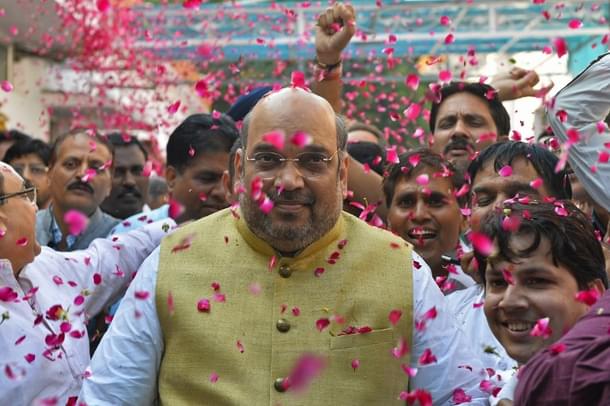
Organisers of events, instead of being congratulated, were told they were promoting themselves. Shah looked at almost every suggestion for candidacy in different seats with suspicion; invariably, he would reject the candidate whom the local leaders picked as the strongest contender in a given constituency. After the results were out, the snubbed workers did not buy the official statement of the party that the BJP had managed to be the single largest party in Maharashtra from the level of being a junior partner of the Shiv Sena or that Jharkhand was a thumping success. They said dozens of more seats in Maharashtra and at least 10 more in Jharkhand could have been theirs if the party chief had listened to them. Somewhat reluctantly, they agreed Haryana was a good show.
Nevertheless, as the Modi wave was still on a high tide, a non-dynastic Devendra Fadnavis, the non-Jat Manohar Lal Khattar and a non-Adivasi Raghubar Das could make it as chief ministers respectively of Maharashtra, Haryana and Jharkhand – and without defections in the state units. By the time they reached Delhi, the Modi wave had begun ebbing even as the Vaishya community had made up its mind to exact revenge for replacing them with Jhas, Mishras and Upadhyays in the state unit and ‘demoting’ Dr Harsh Vardhan (who is a Goyal, in case our readers didn’t know) from Health to the Science & Technology Ministry in the Union Cabinet. In a repeat fiasco, the Bhumihar-Brahmins were treated so badly in north Bihar that in the fourth and fifth phases of the election in that state, which could have compensated for the reverses in the first two phases, went en bloc against the party.
After my post-mortem of the Bihar results, some readers were surprised that I had given Arun Jaitley a “clean chit” despite his “bad economics”. The fact is, I couldn’t have falsified what was my first-hand witness account. So marginalised was Jaitley during the Bihar campaign that (a) members of his team went around BJP offices looking for some work but were cold-shouldered everywhere; (b) he readily gave his unsure and frustrated team members permissions of leave as and when anybody wanted a short trip back to Delhi. It was Shah all the way till the third phase; after that, no patchwork could have salvaged the BJP’s position in the polls.
My sources in the party say Modi was ready to pay Delhi as the price for his revamping effort, but he found the loss of Bihar too much to be taken in his stride. Pushing his economic policy towards the eastern parts of the country, the party’s strength in the Rajya Sabha and influence in the upcoming West Bengal and Uttar Pradesh elections depended on this state.
Last week, an insider to Modi’s 2014 campaign team said that swayamsevaks like him wanted Shah out. The leaders of all state units have, in fact, made up their minds that their favourite candidates will be in place before the party elects its central president again. Since these posts strictly adhere to stated tenures, Shah will not be able to remove them even after re-emerging as the supreme head of the party in case he is re-elected.
Following that drubbing in Bihar, when voices were raised for Shah’s ouster, Modi for the first time did not put his foot down. But he did not agree that Shah’s head must roll either. So we have the most likely scenario of Shah continuing as the BJP President when his ad hoc tenure ends in a month — with powers curtailed. The first signs of this reduced power are visible.
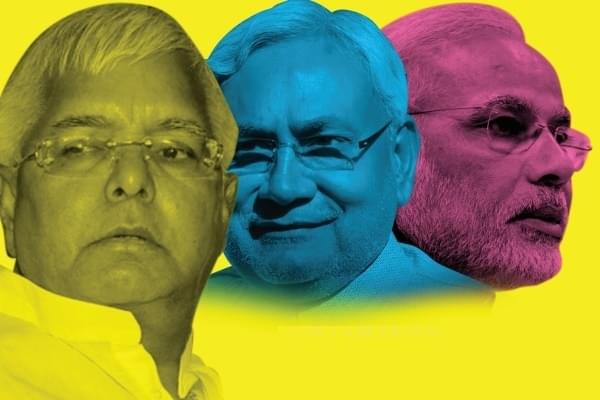
In Uttar Pradesh, the party is again thinking along caste lines: while Shrikant Sharma, a Brahmin face, is likely to be a general secretary to placate the caste that may get miffed by the imminent ouster of incumbent Laxmikant Bajpai, Swatantra Dev Singh will balance the scale as representative of a backward community. It’s Madhya Pradesh Chief Minister Shivraj Singh Chouhan, and not Shah, who has favoured Nandkumar Singh Chauhan to continue as the head of that state’s BJP unit. Dharamlal Kaushik has been allowed to stay as the Chhattisgarh unit’s president because Chief Minister Raman Singh wanted him. Vasundhara Raje has decided it would be Ashok Parnami for a second term as the Rajasthan unit chief.
Where the BJP does not yet have a formidable presence, the RSS has decided Kummanam Rajasekharan would lead the Kerala unit while Dilip Ghosh has been promoted in West Bengal.
It is not that Shah is anti-OBC; he has had no issues with Kalyan Singh, Uma Bharti, Hukum Singh, Nepal Singh, Prem Lata Katiyar and Swatantra Dev Singh — the last name has now re-surfaced — whom the BJP had been keeping in good humour since 2012 to get good results in the Lok Sabha polls. His agenda was to break cosy arrangements between leaders in all the state units. But that agenda is temporarily taking the backseat. SD Singh’s name has not been announced, but his is the name that has met with the largest consensus in the Uttar Pradesh unit of the BJP. In fact, most or all districts of the state will have OBC leaders as presidents, an insider informed Swarajya. He said the central leadership does not wish to challenge the consensus in the state unit.
Similar is the story of Dharamlal Kaushik in Chhattisgarh. While the BJP’s electoral performance has been good in seats dominated by the Scheduled Castes, it was far from impressive in places where OBCs rule the roost. So, Kaushik had come in as a Kurmi. He stays, nullifying Modi’s agenda of defying caste realities deliberately.
If Nandkumar Singh Chauhan is continuing in Madhya Pradesh, it also means that Modi’s unwritten — but hitherto accepted — principle of not sending back MPs to manage their respective home states has been kept in abeyance. By that principle, Nitin Gadkari’s candidacy for Maharashtra chief ministership had been dropped and Dr Harsh Vardhan had not been projected as Delhi’s BJP head. The reversal of the decision was also seen in the act of sending Sarbananda Sonowal back to Assam, which is poll-bound, too.
The ghost of the Deen Dayal Upadhyay Trust land scam of 2006 has been laid to rest; otherwise, Raje’s favourite MLA Ashok Parnami would not have continued as Rajasthan BJP chief. His declared assets might have gone up from Rs 3.66 crore in 2008 to Rs 26.61 crore in 2013, but Shah will have to grin and bear it.
Finally, Hindutva is back on the cards in both Kerala and West Bengal as demagogues have been rewarded in these states. But before leftists drop their jaws seeing their language in our magazine, they must note that it is secular Hindutva, not Muslim-hating rhetoric, with which Rajasekharan has made his mark. He endeared himself to the Hindus of Kerala by demanding that temples be freed from state control. Indeed, if secularism means state policies not being dictated by religion, it equally insists that the state not interfere in religious matters. After all, the Indian Union does not have a say in properties of a church or mosque, does it?
And then, Rajasekharan practices pseudo-secularism as well! While he is known for successfully leading the Hindu protest in 1983 against the claim of a parish to build a church near the Mahadeva temple at Nilakkal, near Sabarimala, when he protested the clearances given to the KGS group of companies for the Aranmula Airport project, he was amply supported by the church along with the whole of the LDF and even sections of the UDF! This contrasts with the scenario in the rest of India where any movement led by an RSS man faces total non-cooperation of Muslim, Christian and Communist organisations. But Kerala’s Christians were ready to back Rajasekharan who also has a more extreme Hindu Munnani, VHP and Hindu Aikyavedi background.
Rajasekharan is known to be close to Cardinal Baselios Mar Cleemis in particular. Local observers believe this is a repeat of the ‘Goa model’ where the BJP could garner Christian votes as well. Rajasekharan could ensure that some Protestants and sections of Latin, Syro-Malabar and Syro-Malankara Catholics support his party, thus breaking the Congress vote-bank while also snatching Hindus from the CPI(M)-led LDF.
Rajasekharan’s ascension will but be resisted in the party, as it comes at the expense of incumbent Vannathanveetil Muraleedharan who had been leading the party in Kerala well, registering victories in village, block and district panchayats last year. Rajasekharan’s detractors say that extracting homilies for Hindus from Christian clerics in seminars or some Christian backing in public demonstrations and getting the community’s votes are two entirely different ballgames.
In West Bengal, Ghosh had joined the BJP from the RSS about a year ago. A high rate of incidents of Hindus being bullied by Muslims under the Mamata Banerjee government only strengthened the Sangh’s resolve to push a local leader who could be trusted by the majority community as a pillar of support. Outgoing West Bengal party President Rahul Sinha had no technical ground to complain as he had completed two terms — the maximum allowed to a candidate as the chief either at the Centre or at the state level.
The problem with Ghosh is the general problem with a typical Sangh appointee: the person is often well-meaning, but politically inept. “He is not an inspirational leader who can rebuild the ghettoised party in West Bengal. He lacks intellect, is inarticulate at best and he does not look like a fighter. Both his backers and detractors feel he can be manipulated to serve their interests,” a journalist who covers the party in the state told me.
Besides this choice of the Sangh overriding reservations from other quarters about Ghosh’s candidacy, the party also wishes to lessen Shah’s stature as a campaigner, which is a big shift since the day when he had addressed a cheering crowd at Esplanade on 30 November 2014, giving a clarion call to “uproot” Trinamool Congress. Gadkari and Rajnath Singh will be other star attractions on the BJP stage.
So, have the Modi-Shah duo given up on their agenda to overhaul the party framework? One can’t say that. Intra-party battles are being fought on multiple fronts. Modi also has to fight the impression that his government is virtually a Jaitley government — a caustic remark by columnist-activist Madhu Kishwar that is increasingly finding resonance among right wingers. He cannot afford subterfuge of the Delhi or sabotage of the Bihar kind in all election-bound states. It could well be a strategic step backward to take a few steps forward at a subsequent, opportune time. As of now, this is the deal for truce: Let the state units decide what the state units ought to do while, at the Centre, Modi has decided Shah will continue.





